Earnings Management and Sustainability
VerifiedAdded on 2020/02/05
|13
|4120
|434
Report
AI Summary
This research paper examines the complex relationship between earnings management and sustainability reporting. It delves into various methods of earnings management, including real activities manipulation and accrual-based adjustments. The paper analyzes how these practices influence the accuracy and reliability of financial information, potentially obscuring a company's true performance and sustainability status. It also explores the implications of earnings management for stakeholders, including investors, creditors, and the environment.
Contribute Materials
Your contribution can guide someone’s learning journey. Share your
documents today.
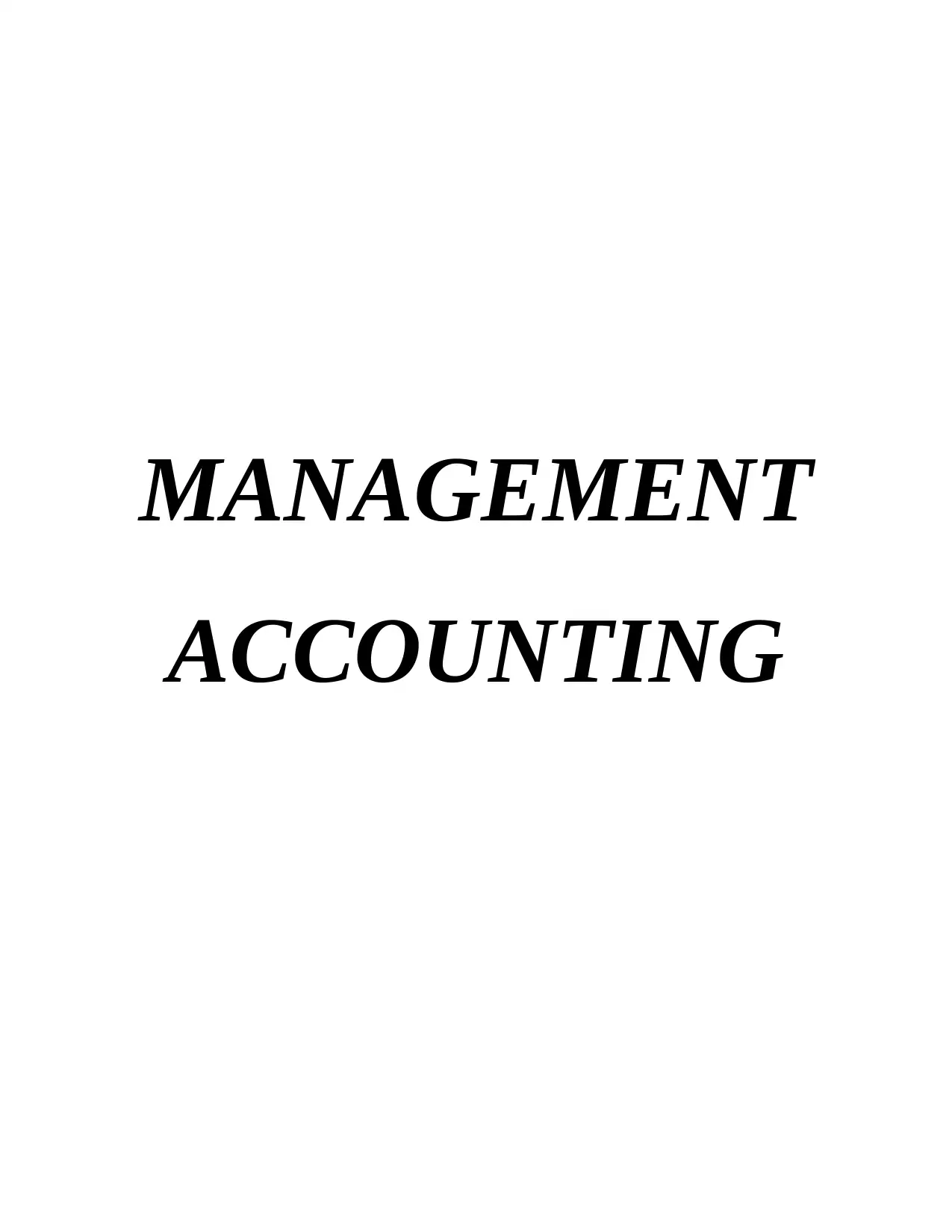
MANAGEMENT
ACCOUNTING
ACCOUNTING
Secure Best Marks with AI Grader
Need help grading? Try our AI Grader for instant feedback on your assignments.
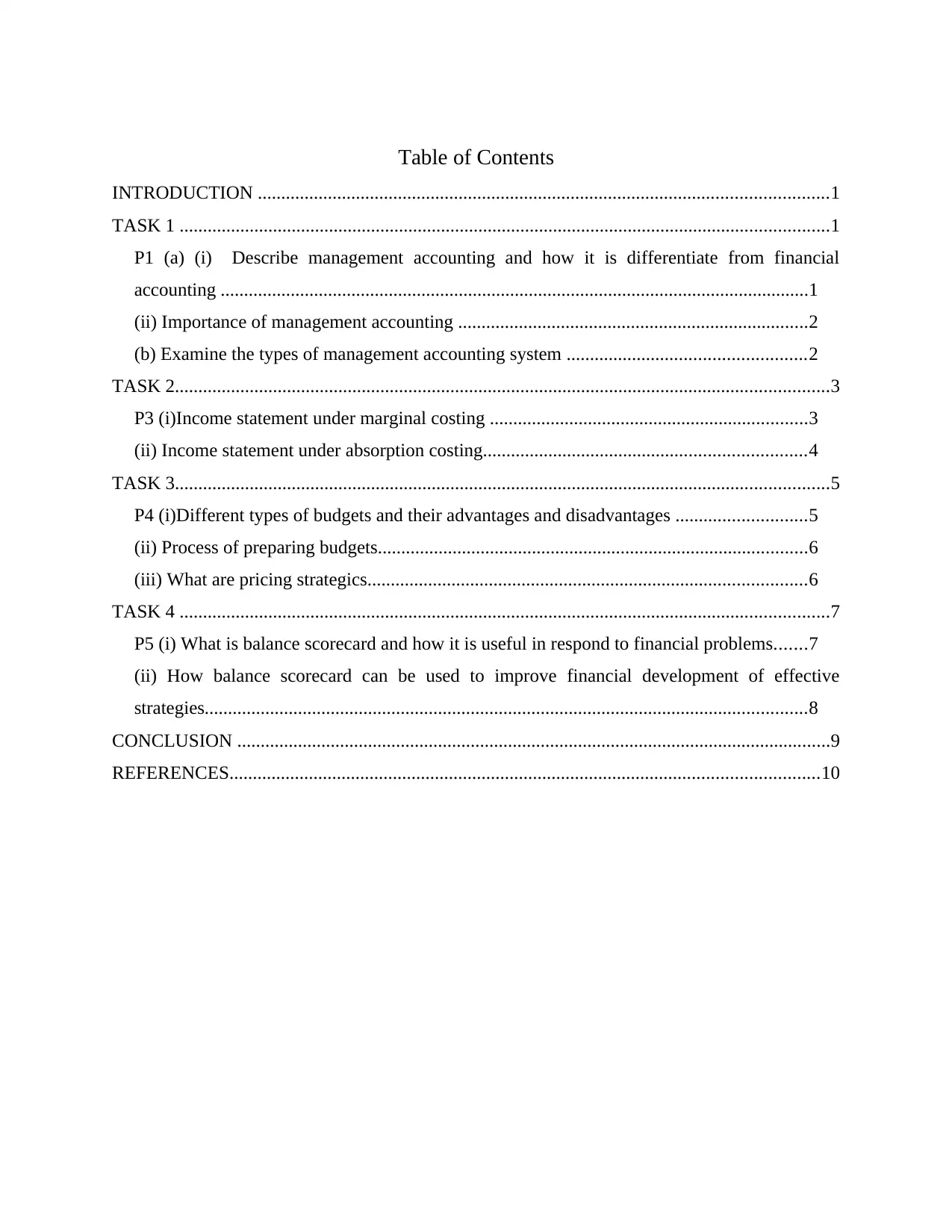
Table of Contents
INTRODUCTION ..........................................................................................................................1
TASK 1 ...........................................................................................................................................1
P1 (a) (i) Describe management accounting and how it is differentiate from financial
accounting ..............................................................................................................................1
(ii) Importance of management accounting ...........................................................................2
(b) Examine the types of management accounting system ...................................................2
TASK 2............................................................................................................................................3
P3 (i)Income statement under marginal costing ....................................................................3
(ii) Income statement under absorption costing.....................................................................4
TASK 3............................................................................................................................................5
P4 (i)Different types of budgets and their advantages and disadvantages ............................5
(ii) Process of preparing budgets............................................................................................6
(iii) What are pricing strategics..............................................................................................6
TASK 4 ...........................................................................................................................................7
P5 (i) What is balance scorecard and how it is useful in respond to financial problems.......7
(ii) How balance scorecard can be used to improve financial development of effective
strategies.................................................................................................................................8
CONCLUSION ...............................................................................................................................9
REFERENCES..............................................................................................................................10
INTRODUCTION ..........................................................................................................................1
TASK 1 ...........................................................................................................................................1
P1 (a) (i) Describe management accounting and how it is differentiate from financial
accounting ..............................................................................................................................1
(ii) Importance of management accounting ...........................................................................2
(b) Examine the types of management accounting system ...................................................2
TASK 2............................................................................................................................................3
P3 (i)Income statement under marginal costing ....................................................................3
(ii) Income statement under absorption costing.....................................................................4
TASK 3............................................................................................................................................5
P4 (i)Different types of budgets and their advantages and disadvantages ............................5
(ii) Process of preparing budgets............................................................................................6
(iii) What are pricing strategics..............................................................................................6
TASK 4 ...........................................................................................................................................7
P5 (i) What is balance scorecard and how it is useful in respond to financial problems.......7
(ii) How balance scorecard can be used to improve financial development of effective
strategies.................................................................................................................................8
CONCLUSION ...............................................................................................................................9
REFERENCES..............................................................................................................................10
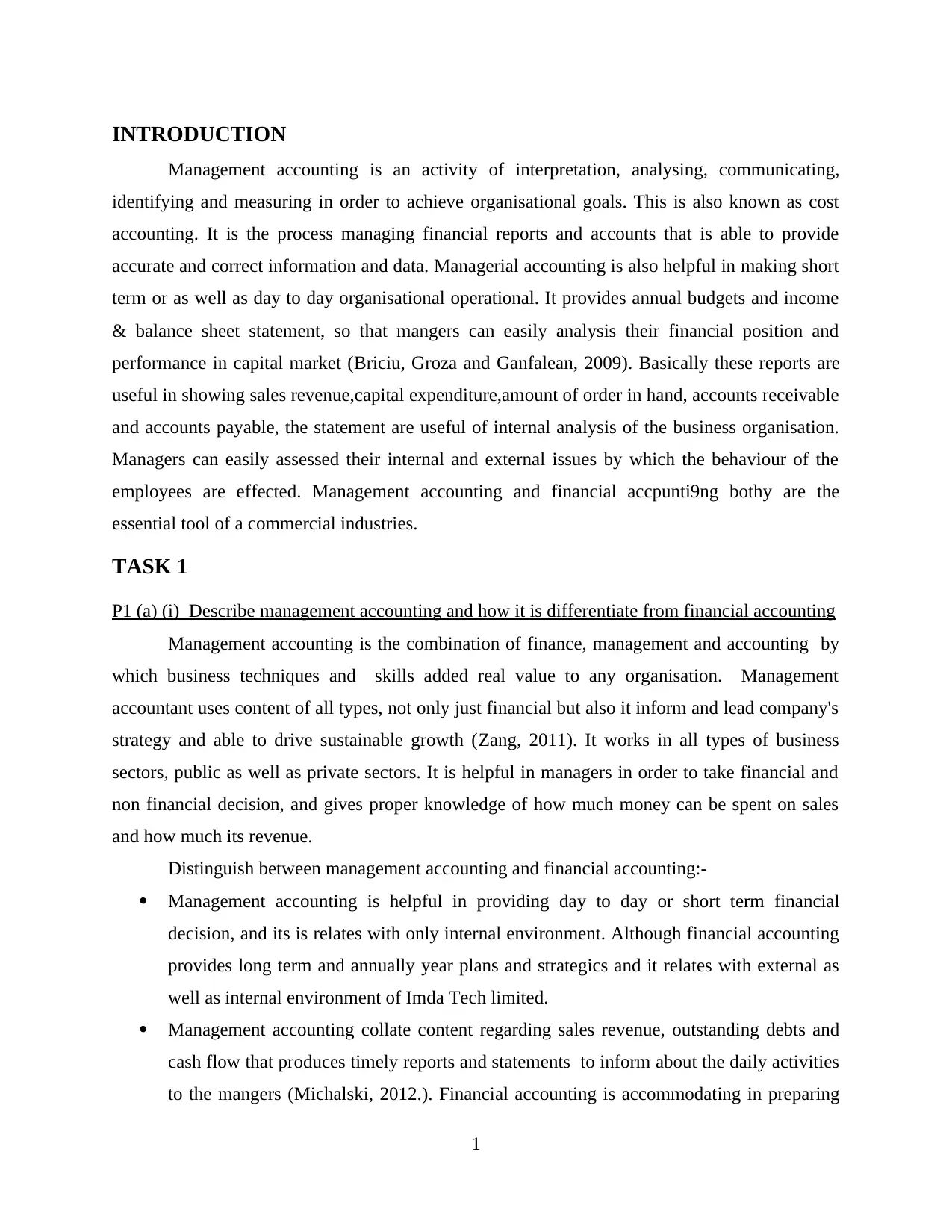
INTRODUCTION
Management accounting is an activity of interpretation, analysing, communicating,
identifying and measuring in order to achieve organisational goals. This is also known as cost
accounting. It is the process managing financial reports and accounts that is able to provide
accurate and correct information and data. Managerial accounting is also helpful in making short
term or as well as day to day organisational operational. It provides annual budgets and income
& balance sheet statement, so that mangers can easily analysis their financial position and
performance in capital market (Briciu, Groza and Ganfalean, 2009). Basically these reports are
useful in showing sales revenue,capital expenditure,amount of order in hand, accounts receivable
and accounts payable, the statement are useful of internal analysis of the business organisation.
Managers can easily assessed their internal and external issues by which the behaviour of the
employees are effected. Management accounting and financial accpunti9ng bothy are the
essential tool of a commercial industries.
TASK 1
P1 (a) (i) Describe management accounting and how it is differentiate from financial accounting
Management accounting is the combination of finance, management and accounting by
which business techniques and skills added real value to any organisation. Management
accountant uses content of all types, not only just financial but also it inform and lead company's
strategy and able to drive sustainable growth (Zang, 2011). It works in all types of business
sectors, public as well as private sectors. It is helpful in managers in order to take financial and
non financial decision, and gives proper knowledge of how much money can be spent on sales
and how much its revenue.
Distinguish between management accounting and financial accounting:-
Management accounting is helpful in providing day to day or short term financial
decision, and its is relates with only internal environment. Although financial accounting
provides long term and annually year plans and strategics and it relates with external as
well as internal environment of Imda Tech limited.
Management accounting collate content regarding sales revenue, outstanding debts and
cash flow that produces timely reports and statements to inform about the daily activities
to the mangers (Michalski, 2012.). Financial accounting is accommodating in preparing
1
Management accounting is an activity of interpretation, analysing, communicating,
identifying and measuring in order to achieve organisational goals. This is also known as cost
accounting. It is the process managing financial reports and accounts that is able to provide
accurate and correct information and data. Managerial accounting is also helpful in making short
term or as well as day to day organisational operational. It provides annual budgets and income
& balance sheet statement, so that mangers can easily analysis their financial position and
performance in capital market (Briciu, Groza and Ganfalean, 2009). Basically these reports are
useful in showing sales revenue,capital expenditure,amount of order in hand, accounts receivable
and accounts payable, the statement are useful of internal analysis of the business organisation.
Managers can easily assessed their internal and external issues by which the behaviour of the
employees are effected. Management accounting and financial accpunti9ng bothy are the
essential tool of a commercial industries.
TASK 1
P1 (a) (i) Describe management accounting and how it is differentiate from financial accounting
Management accounting is the combination of finance, management and accounting by
which business techniques and skills added real value to any organisation. Management
accountant uses content of all types, not only just financial but also it inform and lead company's
strategy and able to drive sustainable growth (Zang, 2011). It works in all types of business
sectors, public as well as private sectors. It is helpful in managers in order to take financial and
non financial decision, and gives proper knowledge of how much money can be spent on sales
and how much its revenue.
Distinguish between management accounting and financial accounting:-
Management accounting is helpful in providing day to day or short term financial
decision, and its is relates with only internal environment. Although financial accounting
provides long term and annually year plans and strategics and it relates with external as
well as internal environment of Imda Tech limited.
Management accounting collate content regarding sales revenue, outstanding debts and
cash flow that produces timely reports and statements to inform about the daily activities
to the mangers (Michalski, 2012.). Financial accounting is accommodating in preparing
1
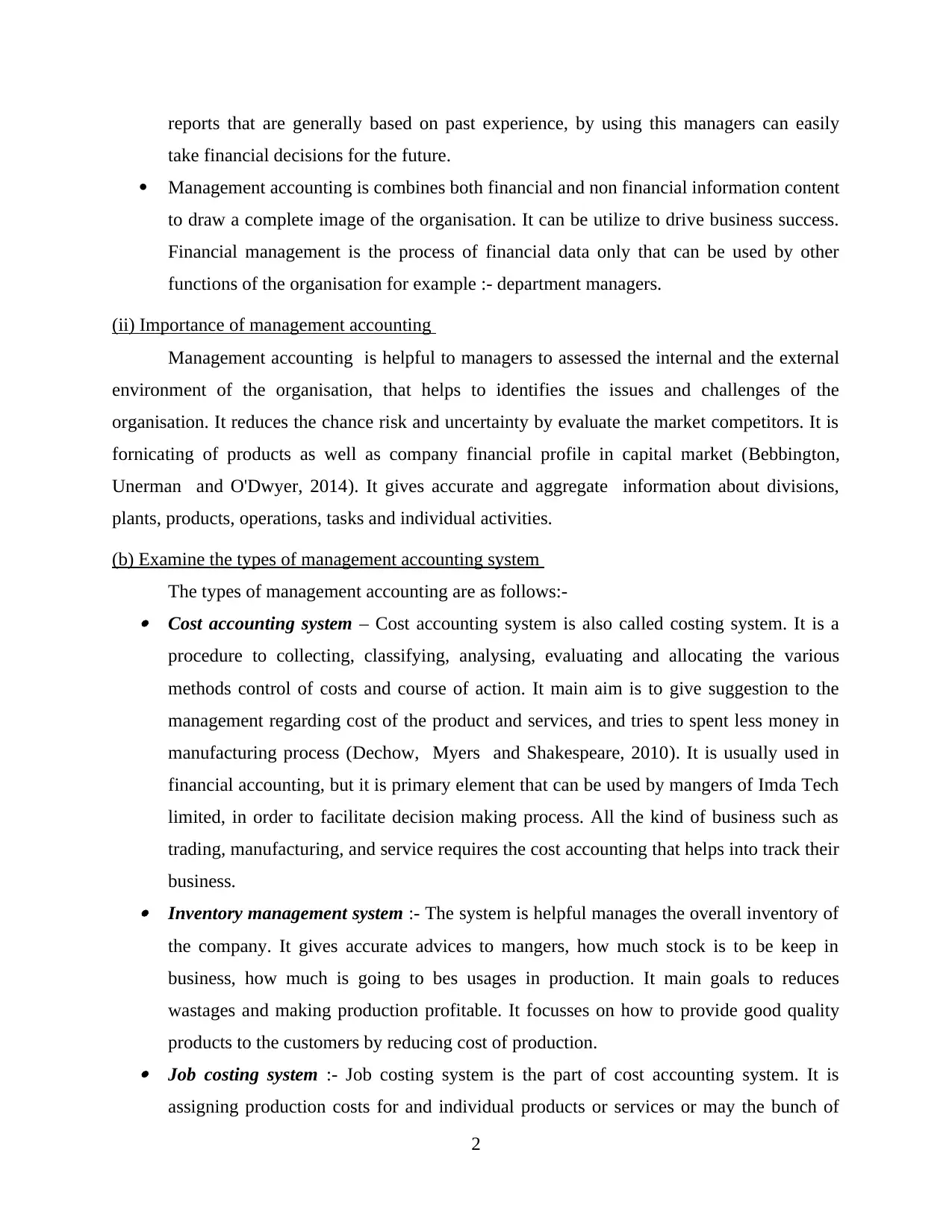
reports that are generally based on past experience, by using this managers can easily
take financial decisions for the future.
Management accounting is combines both financial and non financial information content
to draw a complete image of the organisation. It can be utilize to drive business success.
Financial management is the process of financial data only that can be used by other
functions of the organisation for example :- department managers.
(ii) Importance of management accounting
Management accounting is helpful to managers to assessed the internal and the external
environment of the organisation, that helps to identifies the issues and challenges of the
organisation. It reduces the chance risk and uncertainty by evaluate the market competitors. It is
fornicating of products as well as company financial profile in capital market (Bebbington,
Unerman and O'Dwyer, 2014). It gives accurate and aggregate information about divisions,
plants, products, operations, tasks and individual activities.
(b) Examine the types of management accounting system
The types of management accounting are as follows:- Cost accounting system – Cost accounting system is also called costing system. It is a
procedure to collecting, classifying, analysing, evaluating and allocating the various
methods control of costs and course of action. It main aim is to give suggestion to the
management regarding cost of the product and services, and tries to spent less money in
manufacturing process (Dechow, Myers and Shakespeare, 2010). It is usually used in
financial accounting, but it is primary element that can be used by mangers of Imda Tech
limited, in order to facilitate decision making process. All the kind of business such as
trading, manufacturing, and service requires the cost accounting that helps into track their
business. Inventory management system :- The system is helpful manages the overall inventory of
the company. It gives accurate advices to mangers, how much stock is to be keep in
business, how much is going to bes usages in production. It main goals to reduces
wastages and making production profitable. It focusses on how to provide good quality
products to the customers by reducing cost of production. Job costing system :- Job costing system is the part of cost accounting system. It is
assigning production costs for and individual products or services or may the bunch of
2
take financial decisions for the future.
Management accounting is combines both financial and non financial information content
to draw a complete image of the organisation. It can be utilize to drive business success.
Financial management is the process of financial data only that can be used by other
functions of the organisation for example :- department managers.
(ii) Importance of management accounting
Management accounting is helpful to managers to assessed the internal and the external
environment of the organisation, that helps to identifies the issues and challenges of the
organisation. It reduces the chance risk and uncertainty by evaluate the market competitors. It is
fornicating of products as well as company financial profile in capital market (Bebbington,
Unerman and O'Dwyer, 2014). It gives accurate and aggregate information about divisions,
plants, products, operations, tasks and individual activities.
(b) Examine the types of management accounting system
The types of management accounting are as follows:- Cost accounting system – Cost accounting system is also called costing system. It is a
procedure to collecting, classifying, analysing, evaluating and allocating the various
methods control of costs and course of action. It main aim is to give suggestion to the
management regarding cost of the product and services, and tries to spent less money in
manufacturing process (Dechow, Myers and Shakespeare, 2010). It is usually used in
financial accounting, but it is primary element that can be used by mangers of Imda Tech
limited, in order to facilitate decision making process. All the kind of business such as
trading, manufacturing, and service requires the cost accounting that helps into track their
business. Inventory management system :- The system is helpful manages the overall inventory of
the company. It gives accurate advices to mangers, how much stock is to be keep in
business, how much is going to bes usages in production. It main goals to reduces
wastages and making production profitable. It focusses on how to provide good quality
products to the customers by reducing cost of production. Job costing system :- Job costing system is the part of cost accounting system. It is
assigning production costs for and individual products or services or may the bunch of
2
Secure Best Marks with AI Grader
Need help grading? Try our AI Grader for instant feedback on your assignments.
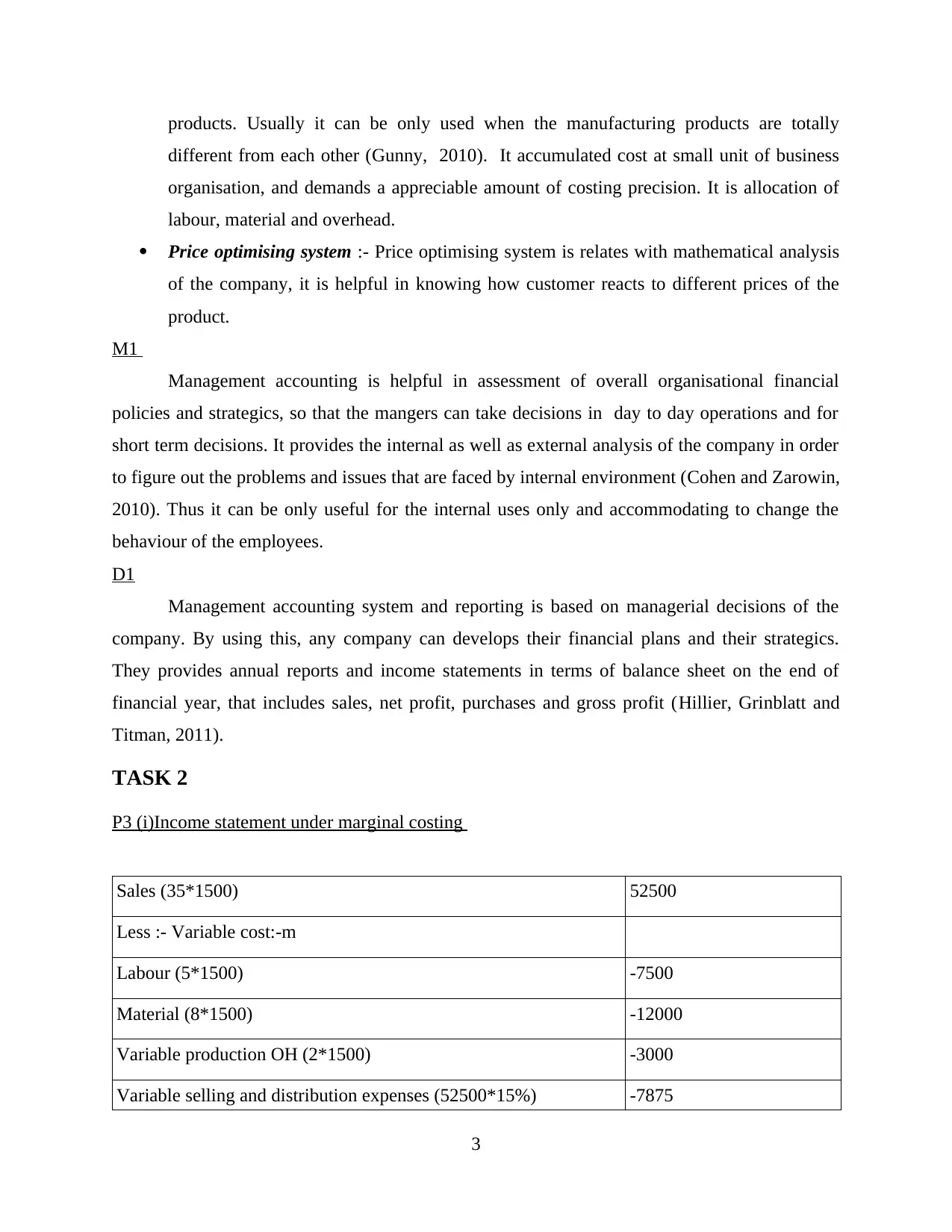
products. Usually it can be only used when the manufacturing products are totally
different from each other (Gunny, 2010). It accumulated cost at small unit of business
organisation, and demands a appreciable amount of costing precision. It is allocation of
labour, material and overhead.
Price optimising system :- Price optimising system is relates with mathematical analysis
of the company, it is helpful in knowing how customer reacts to different prices of the
product.
M1
Management accounting is helpful in assessment of overall organisational financial
policies and strategics, so that the mangers can take decisions in day to day operations and for
short term decisions. It provides the internal as well as external analysis of the company in order
to figure out the problems and issues that are faced by internal environment (Cohen and Zarowin,
2010). Thus it can be only useful for the internal uses only and accommodating to change the
behaviour of the employees.
D1
Management accounting system and reporting is based on managerial decisions of the
company. By using this, any company can develops their financial plans and their strategics.
They provides annual reports and income statements in terms of balance sheet on the end of
financial year, that includes sales, net profit, purchases and gross profit (Hillier, Grinblatt and
Titman, 2011).
TASK 2
P3 (i)Income statement under marginal costing
Sales (35*1500) 52500
Less :- Variable cost:-m
Labour (5*1500) -7500
Material (8*1500) -12000
Variable production OH (2*1500) -3000
Variable selling and distribution expenses (52500*15%) -7875
3
different from each other (Gunny, 2010). It accumulated cost at small unit of business
organisation, and demands a appreciable amount of costing precision. It is allocation of
labour, material and overhead.
Price optimising system :- Price optimising system is relates with mathematical analysis
of the company, it is helpful in knowing how customer reacts to different prices of the
product.
M1
Management accounting is helpful in assessment of overall organisational financial
policies and strategics, so that the mangers can take decisions in day to day operations and for
short term decisions. It provides the internal as well as external analysis of the company in order
to figure out the problems and issues that are faced by internal environment (Cohen and Zarowin,
2010). Thus it can be only useful for the internal uses only and accommodating to change the
behaviour of the employees.
D1
Management accounting system and reporting is based on managerial decisions of the
company. By using this, any company can develops their financial plans and their strategics.
They provides annual reports and income statements in terms of balance sheet on the end of
financial year, that includes sales, net profit, purchases and gross profit (Hillier, Grinblatt and
Titman, 2011).
TASK 2
P3 (i)Income statement under marginal costing
Sales (35*1500) 52500
Less :- Variable cost:-m
Labour (5*1500) -7500
Material (8*1500) -12000
Variable production OH (2*1500) -3000
Variable selling and distribution expenses (52500*15%) -7875
3
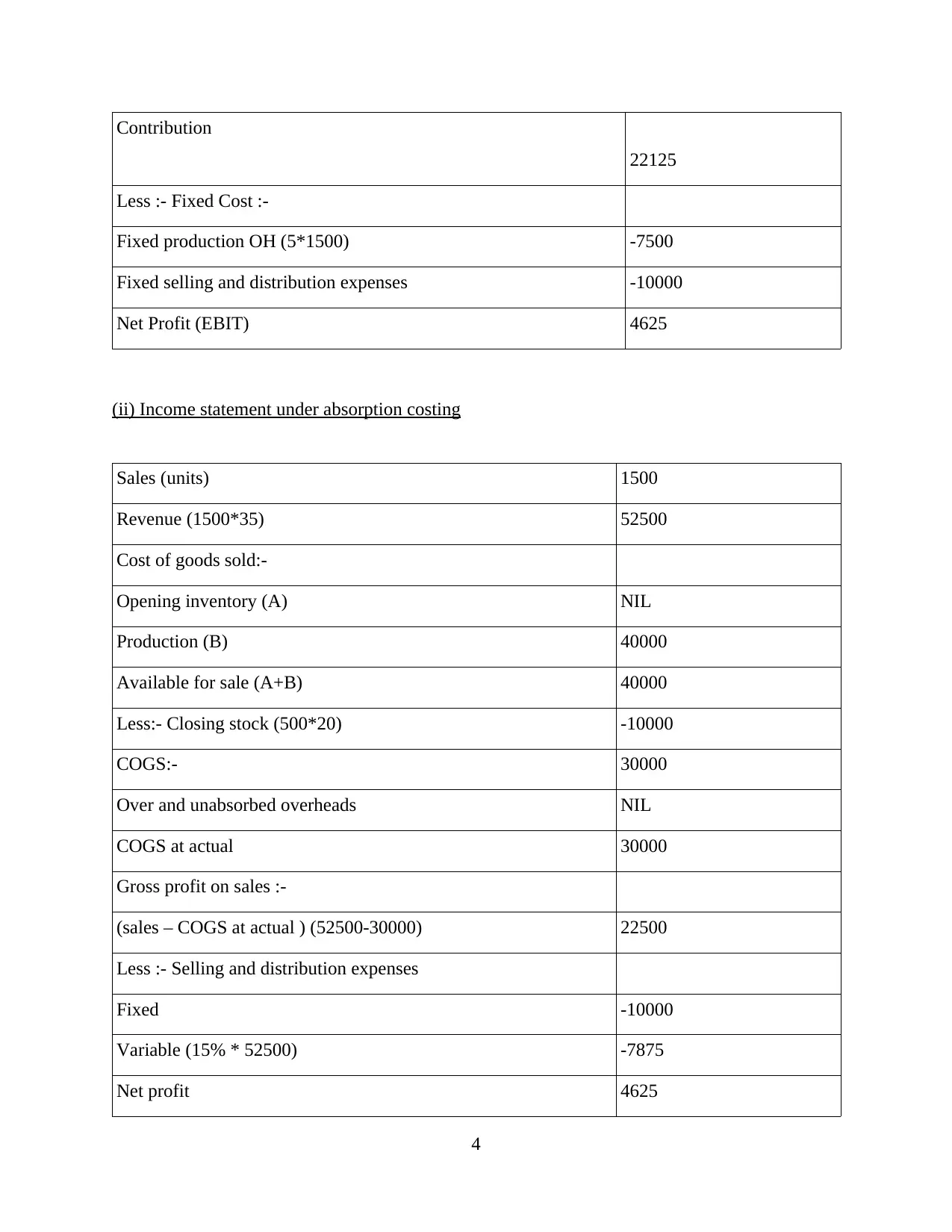
Contribution
22125
Less :- Fixed Cost :-
Fixed production OH (5*1500) -7500
Fixed selling and distribution expenses -10000
Net Profit (EBIT) 4625
(ii) Income statement under absorption costing
Sales (units) 1500
Revenue (1500*35) 52500
Cost of goods sold:-
Opening inventory (A) NIL
Production (B) 40000
Available for sale (A+B) 40000
Less:- Closing stock (500*20) -10000
COGS:- 30000
Over and unabsorbed overheads NIL
COGS at actual 30000
Gross profit on sales :-
(sales – COGS at actual ) (52500-30000) 22500
Less :- Selling and distribution expenses
Fixed -10000
Variable (15% * 52500) -7875
Net profit 4625
4
22125
Less :- Fixed Cost :-
Fixed production OH (5*1500) -7500
Fixed selling and distribution expenses -10000
Net Profit (EBIT) 4625
(ii) Income statement under absorption costing
Sales (units) 1500
Revenue (1500*35) 52500
Cost of goods sold:-
Opening inventory (A) NIL
Production (B) 40000
Available for sale (A+B) 40000
Less:- Closing stock (500*20) -10000
COGS:- 30000
Over and unabsorbed overheads NIL
COGS at actual 30000
Gross profit on sales :-
(sales – COGS at actual ) (52500-30000) 22500
Less :- Selling and distribution expenses
Fixed -10000
Variable (15% * 52500) -7875
Net profit 4625
4
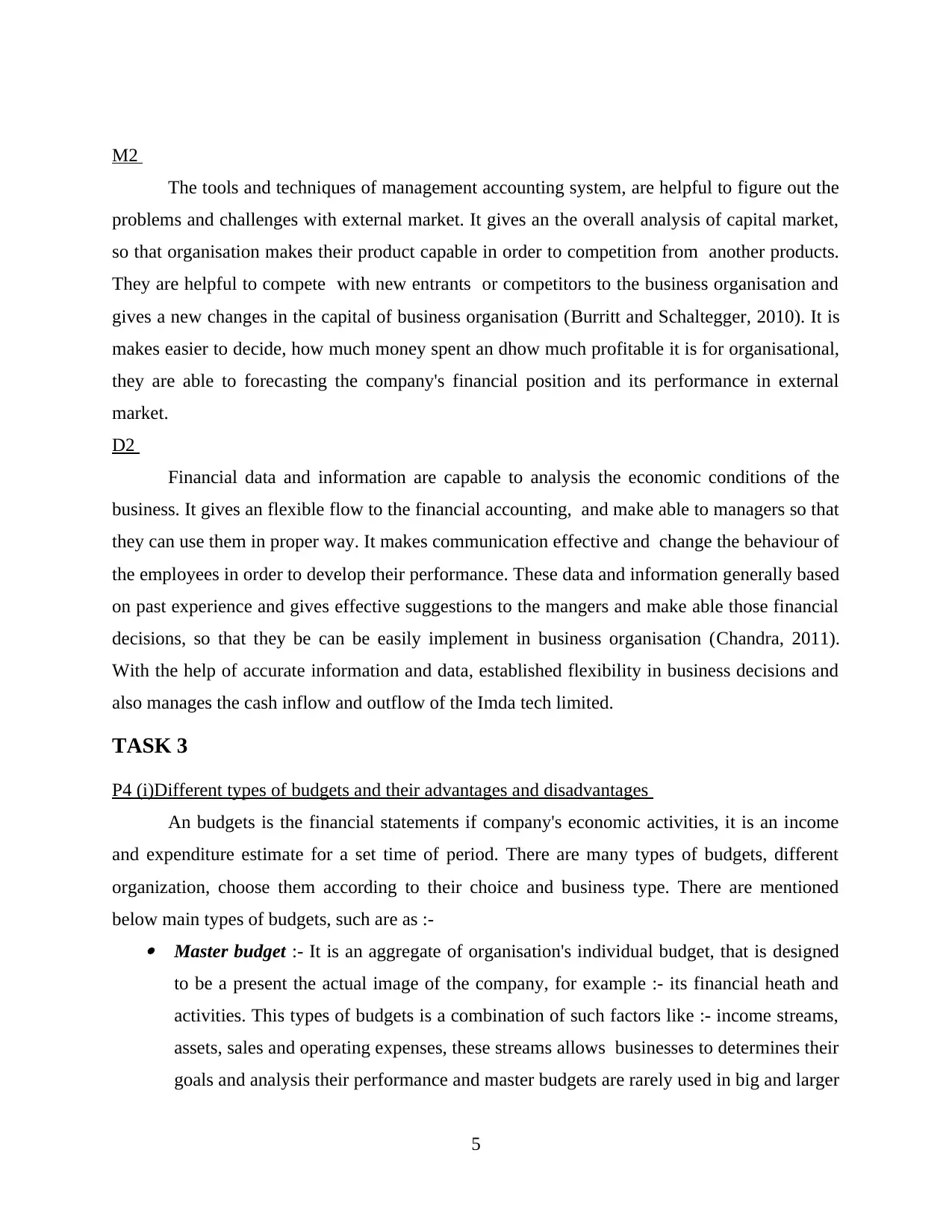
M2
The tools and techniques of management accounting system, are helpful to figure out the
problems and challenges with external market. It gives an the overall analysis of capital market,
so that organisation makes their product capable in order to competition from another products.
They are helpful to compete with new entrants or competitors to the business organisation and
gives a new changes in the capital of business organisation (Burritt and Schaltegger, 2010). It is
makes easier to decide, how much money spent an dhow much profitable it is for organisational,
they are able to forecasting the company's financial position and its performance in external
market.
D2
Financial data and information are capable to analysis the economic conditions of the
business. It gives an flexible flow to the financial accounting, and make able to managers so that
they can use them in proper way. It makes communication effective and change the behaviour of
the employees in order to develop their performance. These data and information generally based
on past experience and gives effective suggestions to the mangers and make able those financial
decisions, so that they be can be easily implement in business organisation (Chandra, 2011).
With the help of accurate information and data, established flexibility in business decisions and
also manages the cash inflow and outflow of the Imda tech limited.
TASK 3
P4 (i)Different types of budgets and their advantages and disadvantages
An budgets is the financial statements if company's economic activities, it is an income
and expenditure estimate for a set time of period. There are many types of budgets, different
organization, choose them according to their choice and business type. There are mentioned
below main types of budgets, such are as :- Master budget :- It is an aggregate of organisation's individual budget, that is designed
to be a present the actual image of the company, for example :- its financial heath and
activities. This types of budgets is a combination of such factors like :- income streams,
assets, sales and operating expenses, these streams allows businesses to determines their
goals and analysis their performance and master budgets are rarely used in big and larger
5
The tools and techniques of management accounting system, are helpful to figure out the
problems and challenges with external market. It gives an the overall analysis of capital market,
so that organisation makes their product capable in order to competition from another products.
They are helpful to compete with new entrants or competitors to the business organisation and
gives a new changes in the capital of business organisation (Burritt and Schaltegger, 2010). It is
makes easier to decide, how much money spent an dhow much profitable it is for organisational,
they are able to forecasting the company's financial position and its performance in external
market.
D2
Financial data and information are capable to analysis the economic conditions of the
business. It gives an flexible flow to the financial accounting, and make able to managers so that
they can use them in proper way. It makes communication effective and change the behaviour of
the employees in order to develop their performance. These data and information generally based
on past experience and gives effective suggestions to the mangers and make able those financial
decisions, so that they be can be easily implement in business organisation (Chandra, 2011).
With the help of accurate information and data, established flexibility in business decisions and
also manages the cash inflow and outflow of the Imda tech limited.
TASK 3
P4 (i)Different types of budgets and their advantages and disadvantages
An budgets is the financial statements if company's economic activities, it is an income
and expenditure estimate for a set time of period. There are many types of budgets, different
organization, choose them according to their choice and business type. There are mentioned
below main types of budgets, such are as :- Master budget :- It is an aggregate of organisation's individual budget, that is designed
to be a present the actual image of the company, for example :- its financial heath and
activities. This types of budgets is a combination of such factors like :- income streams,
assets, sales and operating expenses, these streams allows businesses to determines their
goals and analysis their performance and master budgets are rarely used in big and larger
5
Paraphrase This Document
Need a fresh take? Get an instant paraphrase of this document with our AI Paraphraser
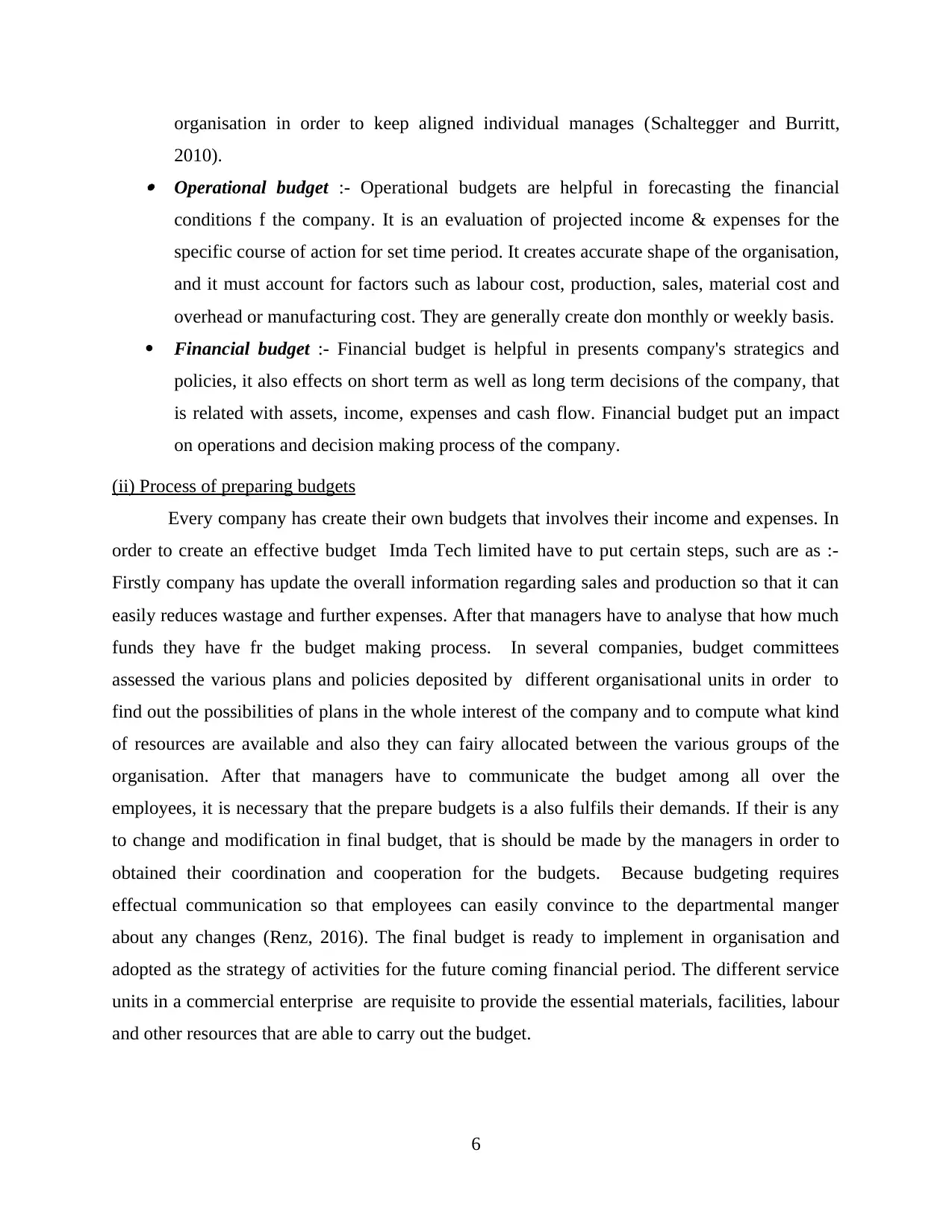
organisation in order to keep aligned individual manages (Schaltegger and Burritt,
2010). Operational budget :- Operational budgets are helpful in forecasting the financial
conditions f the company. It is an evaluation of projected income & expenses for the
specific course of action for set time period. It creates accurate shape of the organisation,
and it must account for factors such as labour cost, production, sales, material cost and
overhead or manufacturing cost. They are generally create don monthly or weekly basis.
Financial budget :- Financial budget is helpful in presents company's strategics and
policies, it also effects on short term as well as long term decisions of the company, that
is related with assets, income, expenses and cash flow. Financial budget put an impact
on operations and decision making process of the company.
(ii) Process of preparing budgets
Every company has create their own budgets that involves their income and expenses. In
order to create an effective budget Imda Tech limited have to put certain steps, such are as :-
Firstly company has update the overall information regarding sales and production so that it can
easily reduces wastage and further expenses. After that managers have to analyse that how much
funds they have fr the budget making process. In several companies, budget committees
assessed the various plans and policies deposited by different organisational units in order to
find out the possibilities of plans in the whole interest of the company and to compute what kind
of resources are available and also they can fairy allocated between the various groups of the
organisation. After that managers have to communicate the budget among all over the
employees, it is necessary that the prepare budgets is a also fulfils their demands. If their is any
to change and modification in final budget, that is should be made by the managers in order to
obtained their coordination and cooperation for the budgets. Because budgeting requires
effectual communication so that employees can easily convince to the departmental manger
about any changes (Renz, 2016). The final budget is ready to implement in organisation and
adopted as the strategy of activities for the future coming financial period. The different service
units in a commercial enterprise are requisite to provide the essential materials, facilities, labour
and other resources that are able to carry out the budget.
6
2010). Operational budget :- Operational budgets are helpful in forecasting the financial
conditions f the company. It is an evaluation of projected income & expenses for the
specific course of action for set time period. It creates accurate shape of the organisation,
and it must account for factors such as labour cost, production, sales, material cost and
overhead or manufacturing cost. They are generally create don monthly or weekly basis.
Financial budget :- Financial budget is helpful in presents company's strategics and
policies, it also effects on short term as well as long term decisions of the company, that
is related with assets, income, expenses and cash flow. Financial budget put an impact
on operations and decision making process of the company.
(ii) Process of preparing budgets
Every company has create their own budgets that involves their income and expenses. In
order to create an effective budget Imda Tech limited have to put certain steps, such are as :-
Firstly company has update the overall information regarding sales and production so that it can
easily reduces wastage and further expenses. After that managers have to analyse that how much
funds they have fr the budget making process. In several companies, budget committees
assessed the various plans and policies deposited by different organisational units in order to
find out the possibilities of plans in the whole interest of the company and to compute what kind
of resources are available and also they can fairy allocated between the various groups of the
organisation. After that managers have to communicate the budget among all over the
employees, it is necessary that the prepare budgets is a also fulfils their demands. If their is any
to change and modification in final budget, that is should be made by the managers in order to
obtained their coordination and cooperation for the budgets. Because budgeting requires
effectual communication so that employees can easily convince to the departmental manger
about any changes (Renz, 2016). The final budget is ready to implement in organisation and
adopted as the strategy of activities for the future coming financial period. The different service
units in a commercial enterprise are requisite to provide the essential materials, facilities, labour
and other resources that are able to carry out the budget.
6
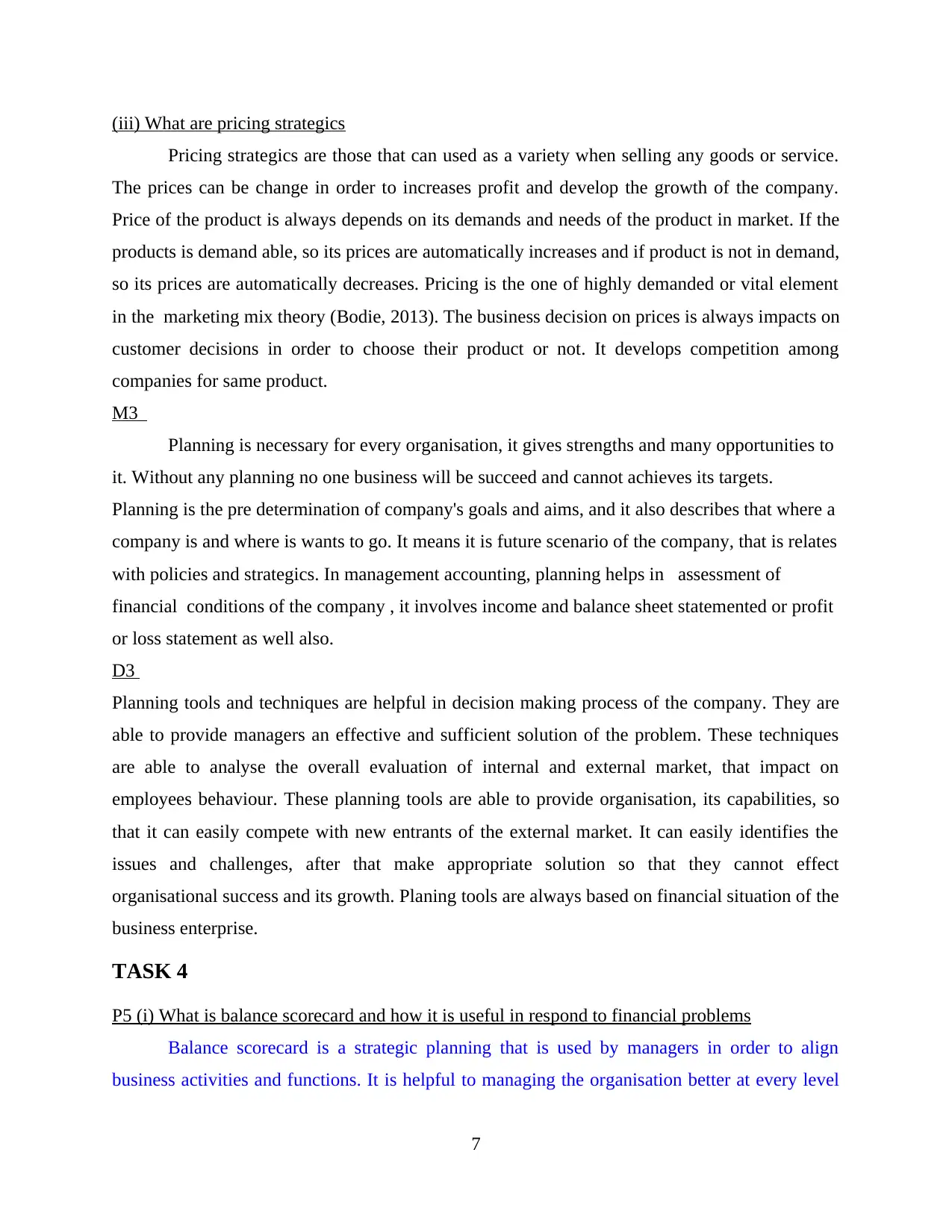
(iii) What are pricing strategics
Pricing strategics are those that can used as a variety when selling any goods or service.
The prices can be change in order to increases profit and develop the growth of the company.
Price of the product is always depends on its demands and needs of the product in market. If the
products is demand able, so its prices are automatically increases and if product is not in demand,
so its prices are automatically decreases. Pricing is the one of highly demanded or vital element
in the marketing mix theory (Bodie, 2013). The business decision on prices is always impacts on
customer decisions in order to choose their product or not. It develops competition among
companies for same product.
M3
Planning is necessary for every organisation, it gives strengths and many opportunities to
it. Without any planning no one business will be succeed and cannot achieves its targets.
Planning is the pre determination of company's goals and aims, and it also describes that where a
company is and where is wants to go. It means it is future scenario of the company, that is relates
with policies and strategics. In management accounting, planning helps in assessment of
financial conditions of the company , it involves income and balance sheet statemented or profit
or loss statement as well also.
D3
Planning tools and techniques are helpful in decision making process of the company. They are
able to provide managers an effective and sufficient solution of the problem. These techniques
are able to analyse the overall evaluation of internal and external market, that impact on
employees behaviour. These planning tools are able to provide organisation, its capabilities, so
that it can easily compete with new entrants of the external market. It can easily identifies the
issues and challenges, after that make appropriate solution so that they cannot effect
organisational success and its growth. Planing tools are always based on financial situation of the
business enterprise.
TASK 4
P5 (i) What is balance scorecard and how it is useful in respond to financial problems
Balance scorecard is a strategic planning that is used by managers in order to align
business activities and functions. It is helpful to managing the organisation better at every level
7
Pricing strategics are those that can used as a variety when selling any goods or service.
The prices can be change in order to increases profit and develop the growth of the company.
Price of the product is always depends on its demands and needs of the product in market. If the
products is demand able, so its prices are automatically increases and if product is not in demand,
so its prices are automatically decreases. Pricing is the one of highly demanded or vital element
in the marketing mix theory (Bodie, 2013). The business decision on prices is always impacts on
customer decisions in order to choose their product or not. It develops competition among
companies for same product.
M3
Planning is necessary for every organisation, it gives strengths and many opportunities to
it. Without any planning no one business will be succeed and cannot achieves its targets.
Planning is the pre determination of company's goals and aims, and it also describes that where a
company is and where is wants to go. It means it is future scenario of the company, that is relates
with policies and strategics. In management accounting, planning helps in assessment of
financial conditions of the company , it involves income and balance sheet statemented or profit
or loss statement as well also.
D3
Planning tools and techniques are helpful in decision making process of the company. They are
able to provide managers an effective and sufficient solution of the problem. These techniques
are able to analyse the overall evaluation of internal and external market, that impact on
employees behaviour. These planning tools are able to provide organisation, its capabilities, so
that it can easily compete with new entrants of the external market. It can easily identifies the
issues and challenges, after that make appropriate solution so that they cannot effect
organisational success and its growth. Planing tools are always based on financial situation of the
business enterprise.
TASK 4
P5 (i) What is balance scorecard and how it is useful in respond to financial problems
Balance scorecard is a strategic planning that is used by managers in order to align
business activities and functions. It is helpful to managing the organisation better at every level
7
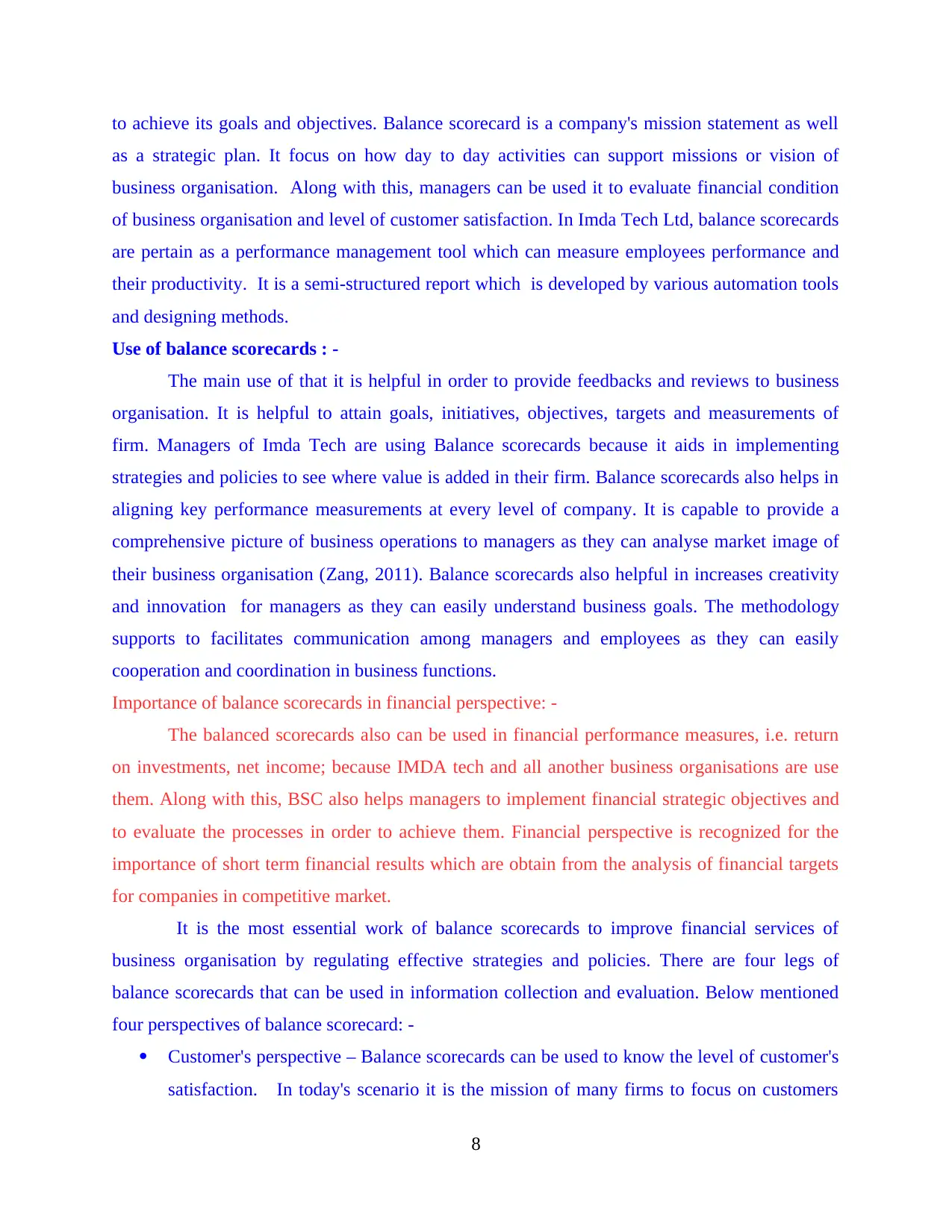
to achieve its goals and objectives. Balance scorecard is a company's mission statement as well
as a strategic plan. It focus on how day to day activities can support missions or vision of
business organisation. Along with this, managers can be used it to evaluate financial condition
of business organisation and level of customer satisfaction. In Imda Tech Ltd, balance scorecards
are pertain as a performance management tool which can measure employees performance and
their productivity. It is a semi-structured report which is developed by various automation tools
and designing methods.
Use of balance scorecards : -
The main use of that it is helpful in order to provide feedbacks and reviews to business
organisation. It is helpful to attain goals, initiatives, objectives, targets and measurements of
firm. Managers of Imda Tech are using Balance scorecards because it aids in implementing
strategies and policies to see where value is added in their firm. Balance scorecards also helps in
aligning key performance measurements at every level of company. It is capable to provide a
comprehensive picture of business operations to managers as they can analyse market image of
their business organisation (Zang, 2011). Balance scorecards also helpful in increases creativity
and innovation for managers as they can easily understand business goals. The methodology
supports to facilitates communication among managers and employees as they can easily
cooperation and coordination in business functions.
Importance of balance scorecards in financial perspective: -
The balanced scorecards also can be used in financial performance measures, i.e. return
on investments, net income; because IMDA tech and all another business organisations are use
them. Along with this, BSC also helps managers to implement financial strategic objectives and
to evaluate the processes in order to achieve them. Financial perspective is recognized for the
importance of short term financial results which are obtain from the analysis of financial targets
for companies in competitive market.
It is the most essential work of balance scorecards to improve financial services of
business organisation by regulating effective strategies and policies. There are four legs of
balance scorecards that can be used in information collection and evaluation. Below mentioned
four perspectives of balance scorecard: -
Customer's perspective – Balance scorecards can be used to know the level of customer's
satisfaction. In today's scenario it is the mission of many firms to focus on customers
8
as a strategic plan. It focus on how day to day activities can support missions or vision of
business organisation. Along with this, managers can be used it to evaluate financial condition
of business organisation and level of customer satisfaction. In Imda Tech Ltd, balance scorecards
are pertain as a performance management tool which can measure employees performance and
their productivity. It is a semi-structured report which is developed by various automation tools
and designing methods.
Use of balance scorecards : -
The main use of that it is helpful in order to provide feedbacks and reviews to business
organisation. It is helpful to attain goals, initiatives, objectives, targets and measurements of
firm. Managers of Imda Tech are using Balance scorecards because it aids in implementing
strategies and policies to see where value is added in their firm. Balance scorecards also helps in
aligning key performance measurements at every level of company. It is capable to provide a
comprehensive picture of business operations to managers as they can analyse market image of
their business organisation (Zang, 2011). Balance scorecards also helpful in increases creativity
and innovation for managers as they can easily understand business goals. The methodology
supports to facilitates communication among managers and employees as they can easily
cooperation and coordination in business functions.
Importance of balance scorecards in financial perspective: -
The balanced scorecards also can be used in financial performance measures, i.e. return
on investments, net income; because IMDA tech and all another business organisations are use
them. Along with this, BSC also helps managers to implement financial strategic objectives and
to evaluate the processes in order to achieve them. Financial perspective is recognized for the
importance of short term financial results which are obtain from the analysis of financial targets
for companies in competitive market.
It is the most essential work of balance scorecards to improve financial services of
business organisation by regulating effective strategies and policies. There are four legs of
balance scorecards that can be used in information collection and evaluation. Below mentioned
four perspectives of balance scorecard: -
Customer's perspective – Balance scorecards can be used to know the level of customer's
satisfaction. In today's scenario it is the mission of many firms to focus on customers
8
Secure Best Marks with AI Grader
Need help grading? Try our AI Grader for instant feedback on your assignments.
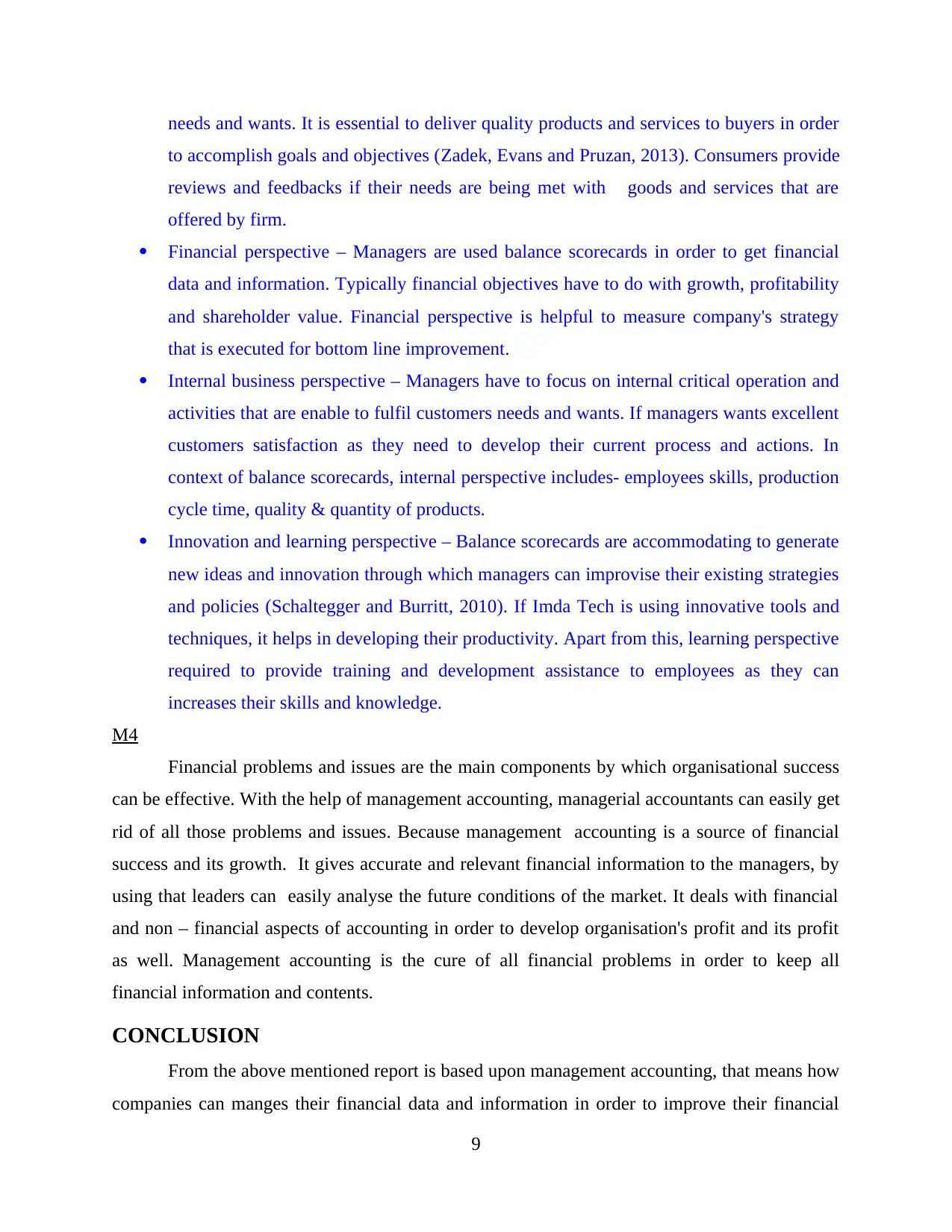
needs and wants. It is essential to deliver quality products and services to buyers in order
to accomplish goals and objectives (Zadek, Evans and Pruzan, 2013). Consumers provide
reviews and feedbacks if their needs are being met with goods and services that are
offered by firm.
Financial perspective – Managers are used balance scorecards in order to get financial
data and information. Typically financial objectives have to do with growth, profitability
and shareholder value. Financial perspective is helpful to measure company's strategy
that is executed for bottom line improvement.
Internal business perspective – Managers have to focus on internal critical operation and
activities that are enable to fulfil customers needs and wants. If managers wants excellent
customers satisfaction as they need to develop their current process and actions. In
context of balance scorecards, internal perspective includes- employees skills, production
cycle time, quality & quantity of products.
Innovation and learning perspective – Balance scorecards are accommodating to generate
new ideas and innovation through which managers can improvise their existing strategies
and policies (Schaltegger and Burritt, 2010). If Imda Tech is using innovative tools and
techniques, it helps in developing their productivity. Apart from this, learning perspective
required to provide training and development assistance to employees as they can
increases their skills and knowledge.
M4
Financial problems and issues are the main components by which organisational success
can be effective. With the help of management accounting, managerial accountants can easily get
rid of all those problems and issues. Because management accounting is a source of financial
success and its growth. It gives accurate and relevant financial information to the managers, by
using that leaders can easily analyse the future conditions of the market. It deals with financial
and non – financial aspects of accounting in order to develop organisation's profit and its profit
as well. Management accounting is the cure of all financial problems in order to keep all
financial information and contents.
CONCLUSION
From the above mentioned report is based upon management accounting, that means how
companies can manges their financial data and information in order to improve their financial
9
to accomplish goals and objectives (Zadek, Evans and Pruzan, 2013). Consumers provide
reviews and feedbacks if their needs are being met with goods and services that are
offered by firm.
Financial perspective – Managers are used balance scorecards in order to get financial
data and information. Typically financial objectives have to do with growth, profitability
and shareholder value. Financial perspective is helpful to measure company's strategy
that is executed for bottom line improvement.
Internal business perspective – Managers have to focus on internal critical operation and
activities that are enable to fulfil customers needs and wants. If managers wants excellent
customers satisfaction as they need to develop their current process and actions. In
context of balance scorecards, internal perspective includes- employees skills, production
cycle time, quality & quantity of products.
Innovation and learning perspective – Balance scorecards are accommodating to generate
new ideas and innovation through which managers can improvise their existing strategies
and policies (Schaltegger and Burritt, 2010). If Imda Tech is using innovative tools and
techniques, it helps in developing their productivity. Apart from this, learning perspective
required to provide training and development assistance to employees as they can
increases their skills and knowledge.
M4
Financial problems and issues are the main components by which organisational success
can be effective. With the help of management accounting, managerial accountants can easily get
rid of all those problems and issues. Because management accounting is a source of financial
success and its growth. It gives accurate and relevant financial information to the managers, by
using that leaders can easily analyse the future conditions of the market. It deals with financial
and non – financial aspects of accounting in order to develop organisation's profit and its profit
as well. Management accounting is the cure of all financial problems in order to keep all
financial information and contents.
CONCLUSION
From the above mentioned report is based upon management accounting, that means how
companies can manges their financial data and information in order to improve their financial
9
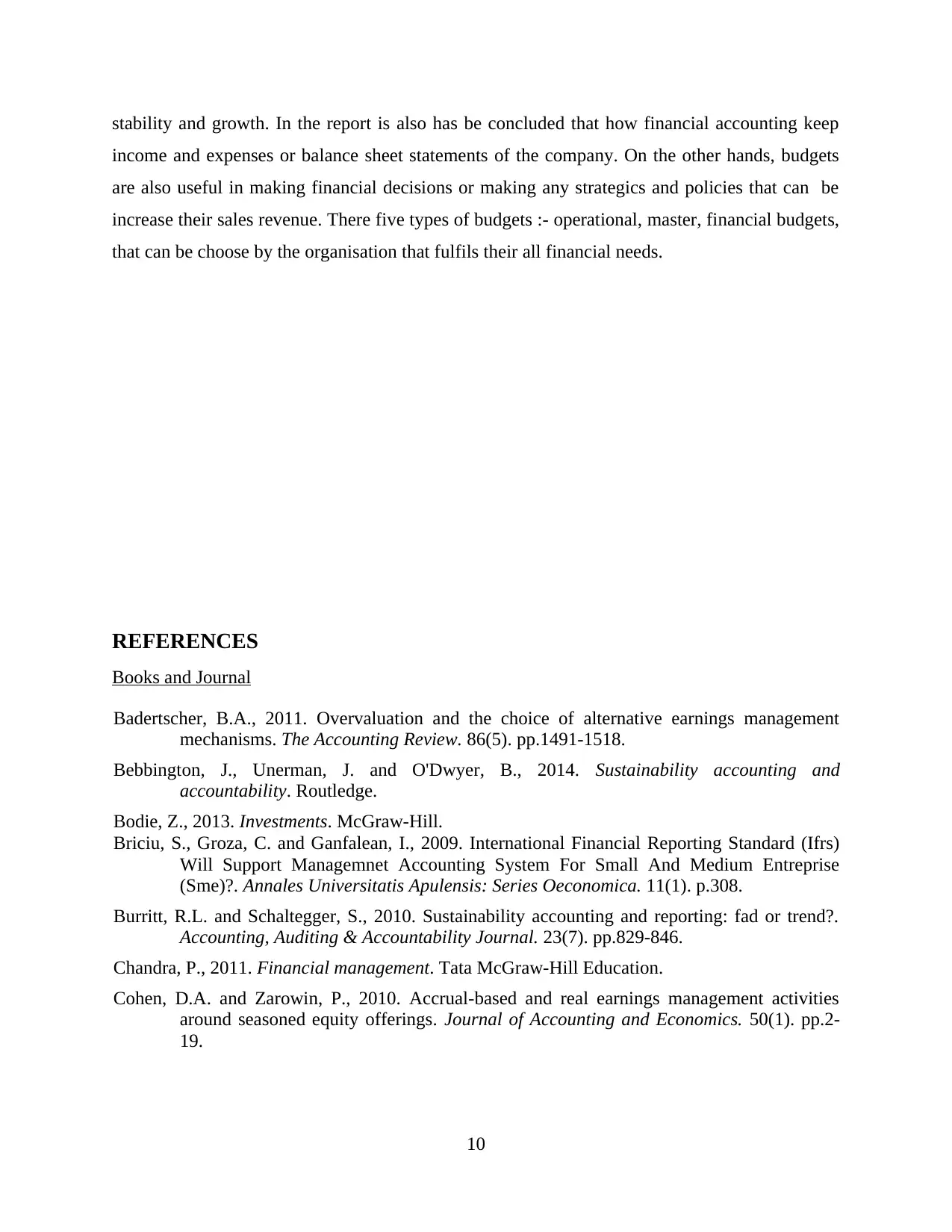
stability and growth. In the report is also has be concluded that how financial accounting keep
income and expenses or balance sheet statements of the company. On the other hands, budgets
are also useful in making financial decisions or making any strategics and policies that can be
increase their sales revenue. There five types of budgets :- operational, master, financial budgets,
that can be choose by the organisation that fulfils their all financial needs.
REFERENCES
Books and Journal
Badertscher, B.A., 2011. Overvaluation and the choice of alternative earnings management
mechanisms. The Accounting Review. 86(5). pp.1491-1518.
Bebbington, J., Unerman, J. and O'Dwyer, B., 2014. Sustainability accounting and
accountability. Routledge.
Bodie, Z., 2013. Investments. McGraw-Hill.
Briciu, S., Groza, C. and Ganfalean, I., 2009. International Financial Reporting Standard (Ifrs)
Will Support Managemnet Accounting System For Small And Medium Entreprise
(Sme)?. Annales Universitatis Apulensis: Series Oeconomica. 11(1). p.308.
Burritt, R.L. and Schaltegger, S., 2010. Sustainability accounting and reporting: fad or trend?.
Accounting, Auditing & Accountability Journal. 23(7). pp.829-846.
Chandra, P., 2011. Financial management. Tata McGraw-Hill Education.
Cohen, D.A. and Zarowin, P., 2010. Accrual-based and real earnings management activities
around seasoned equity offerings. Journal of Accounting and Economics. 50(1). pp.2-
19.
10
income and expenses or balance sheet statements of the company. On the other hands, budgets
are also useful in making financial decisions or making any strategics and policies that can be
increase their sales revenue. There five types of budgets :- operational, master, financial budgets,
that can be choose by the organisation that fulfils their all financial needs.
REFERENCES
Books and Journal
Badertscher, B.A., 2011. Overvaluation and the choice of alternative earnings management
mechanisms. The Accounting Review. 86(5). pp.1491-1518.
Bebbington, J., Unerman, J. and O'Dwyer, B., 2014. Sustainability accounting and
accountability. Routledge.
Bodie, Z., 2013. Investments. McGraw-Hill.
Briciu, S., Groza, C. and Ganfalean, I., 2009. International Financial Reporting Standard (Ifrs)
Will Support Managemnet Accounting System For Small And Medium Entreprise
(Sme)?. Annales Universitatis Apulensis: Series Oeconomica. 11(1). p.308.
Burritt, R.L. and Schaltegger, S., 2010. Sustainability accounting and reporting: fad or trend?.
Accounting, Auditing & Accountability Journal. 23(7). pp.829-846.
Chandra, P., 2011. Financial management. Tata McGraw-Hill Education.
Cohen, D.A. and Zarowin, P., 2010. Accrual-based and real earnings management activities
around seasoned equity offerings. Journal of Accounting and Economics. 50(1). pp.2-
19.
10
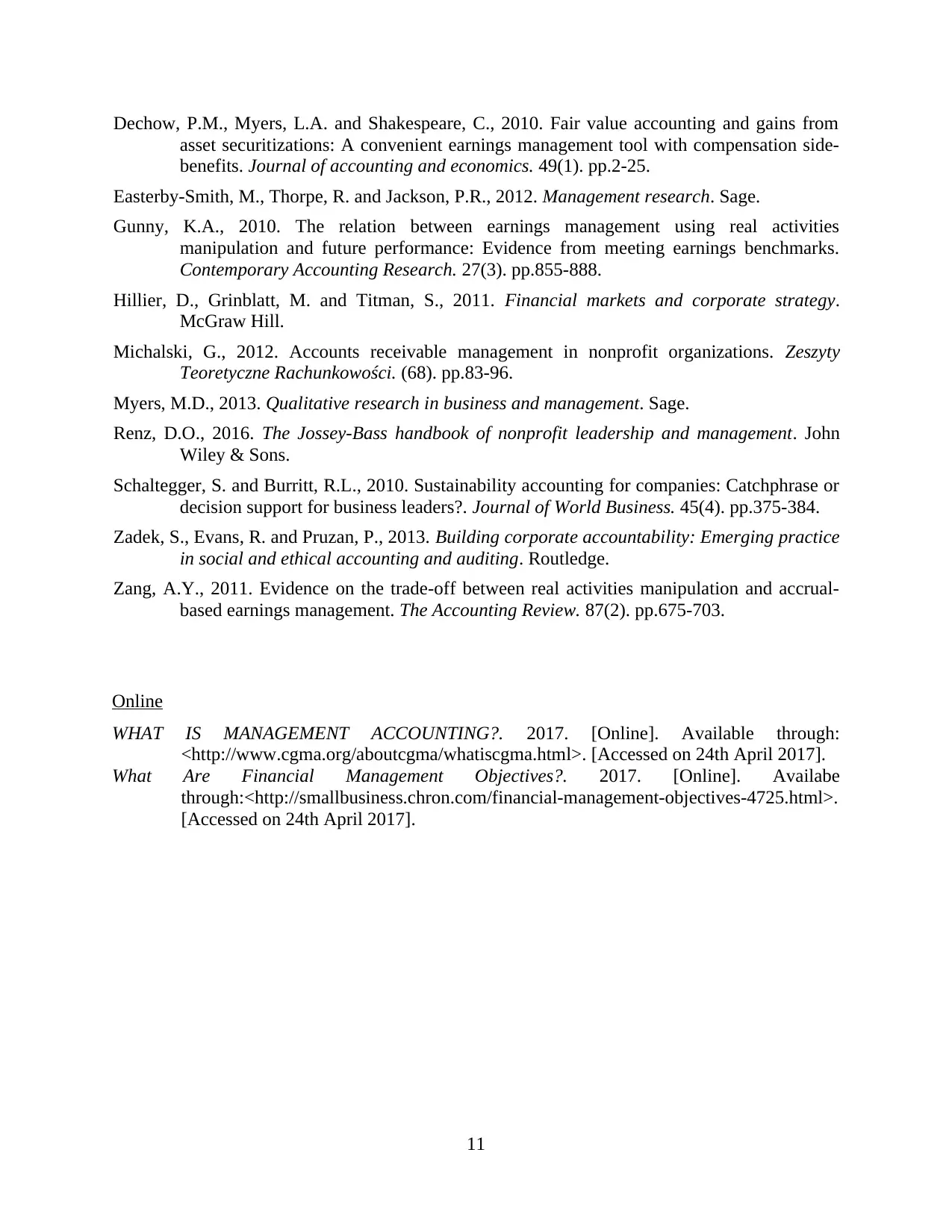
Dechow, P.M., Myers, L.A. and Shakespeare, C., 2010. Fair value accounting and gains from
asset securitizations: A convenient earnings management tool with compensation side-
benefits. Journal of accounting and economics. 49(1). pp.2-25.
Easterby-Smith, M., Thorpe, R. and Jackson, P.R., 2012. Management research. Sage.
Gunny, K.A., 2010. The relation between earnings management using real activities
manipulation and future performance: Evidence from meeting earnings benchmarks.
Contemporary Accounting Research. 27(3). pp.855-888.
Hillier, D., Grinblatt, M. and Titman, S., 2011. Financial markets and corporate strategy.
McGraw Hill.
Michalski, G., 2012. Accounts receivable management in nonprofit organizations. Zeszyty
Teoretyczne Rachunkowości. (68). pp.83-96.
Myers, M.D., 2013. Qualitative research in business and management. Sage.
Renz, D.O., 2016. The Jossey-Bass handbook of nonprofit leadership and management. John
Wiley & Sons.
Schaltegger, S. and Burritt, R.L., 2010. Sustainability accounting for companies: Catchphrase or
decision support for business leaders?. Journal of World Business. 45(4). pp.375-384.
Zadek, S., Evans, R. and Pruzan, P., 2013. Building corporate accountability: Emerging practice
in social and ethical accounting and auditing. Routledge.
Zang, A.Y., 2011. Evidence on the trade-off between real activities manipulation and accrual-
based earnings management. The Accounting Review. 87(2). pp.675-703.
Online
WHAT IS MANAGEMENT ACCOUNTING?. 2017. [Online]. Available through:
<http://www.cgma.org/aboutcgma/whatiscgma.html>. [Accessed on 24th April 2017].
What Are Financial Management Objectives?. 2017. [Online]. Availabe
through:<http://smallbusiness.chron.com/financial-management-objectives-4725.html>.
[Accessed on 24th April 2017].
11
asset securitizations: A convenient earnings management tool with compensation side-
benefits. Journal of accounting and economics. 49(1). pp.2-25.
Easterby-Smith, M., Thorpe, R. and Jackson, P.R., 2012. Management research. Sage.
Gunny, K.A., 2010. The relation between earnings management using real activities
manipulation and future performance: Evidence from meeting earnings benchmarks.
Contemporary Accounting Research. 27(3). pp.855-888.
Hillier, D., Grinblatt, M. and Titman, S., 2011. Financial markets and corporate strategy.
McGraw Hill.
Michalski, G., 2012. Accounts receivable management in nonprofit organizations. Zeszyty
Teoretyczne Rachunkowości. (68). pp.83-96.
Myers, M.D., 2013. Qualitative research in business and management. Sage.
Renz, D.O., 2016. The Jossey-Bass handbook of nonprofit leadership and management. John
Wiley & Sons.
Schaltegger, S. and Burritt, R.L., 2010. Sustainability accounting for companies: Catchphrase or
decision support for business leaders?. Journal of World Business. 45(4). pp.375-384.
Zadek, S., Evans, R. and Pruzan, P., 2013. Building corporate accountability: Emerging practice
in social and ethical accounting and auditing. Routledge.
Zang, A.Y., 2011. Evidence on the trade-off between real activities manipulation and accrual-
based earnings management. The Accounting Review. 87(2). pp.675-703.
Online
WHAT IS MANAGEMENT ACCOUNTING?. 2017. [Online]. Available through:
<http://www.cgma.org/aboutcgma/whatiscgma.html>. [Accessed on 24th April 2017].
What Are Financial Management Objectives?. 2017. [Online]. Availabe
through:<http://smallbusiness.chron.com/financial-management-objectives-4725.html>.
[Accessed on 24th April 2017].
11
1 out of 13
Related Documents
Your All-in-One AI-Powered Toolkit for Academic Success.
+13062052269
info@desklib.com
Available 24*7 on WhatsApp / Email
![[object Object]](/_next/static/media/star-bottom.7253800d.svg)
Unlock your academic potential
© 2024 | Zucol Services PVT LTD | All rights reserved.





